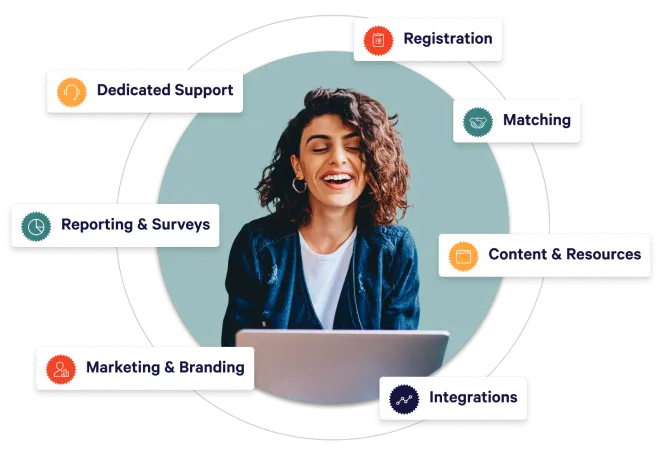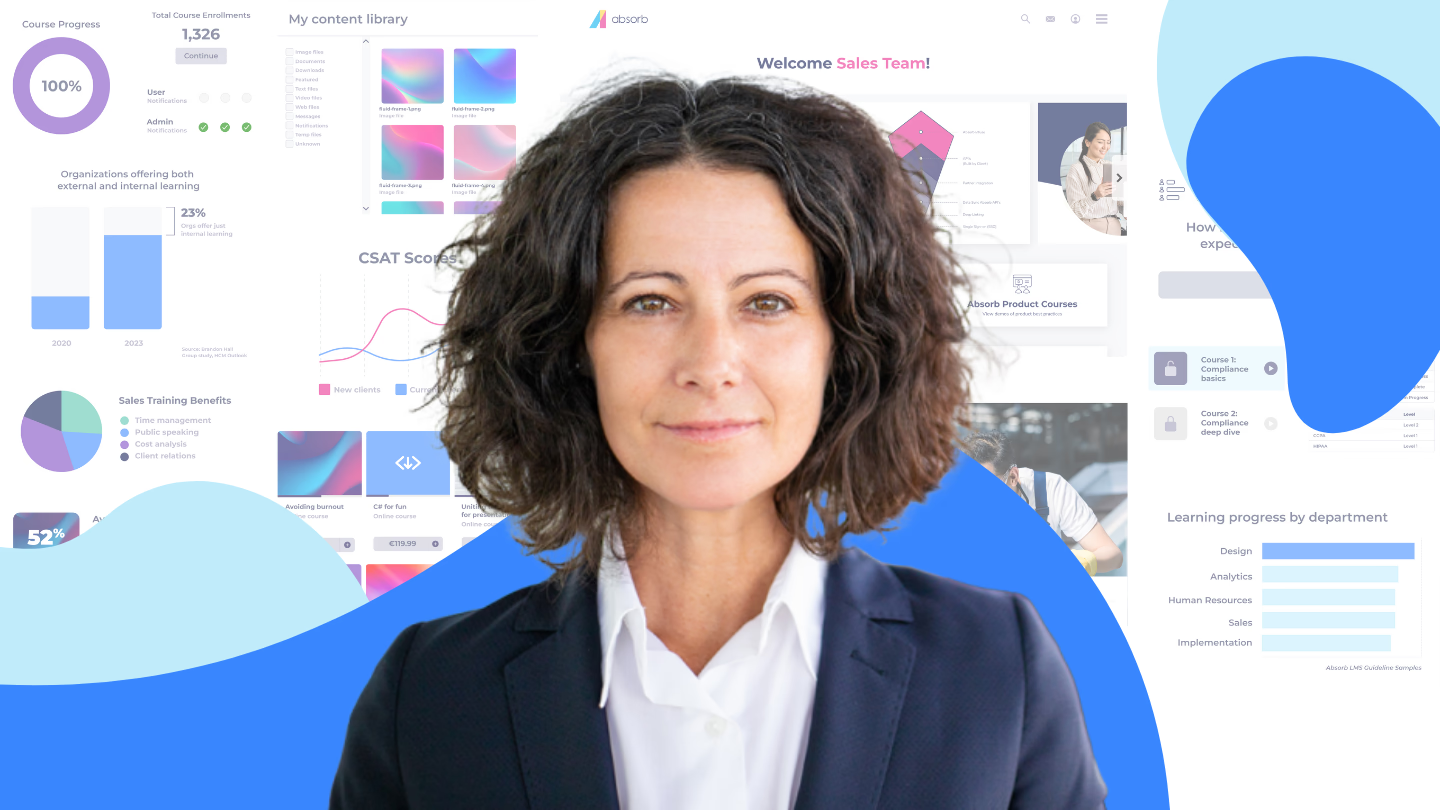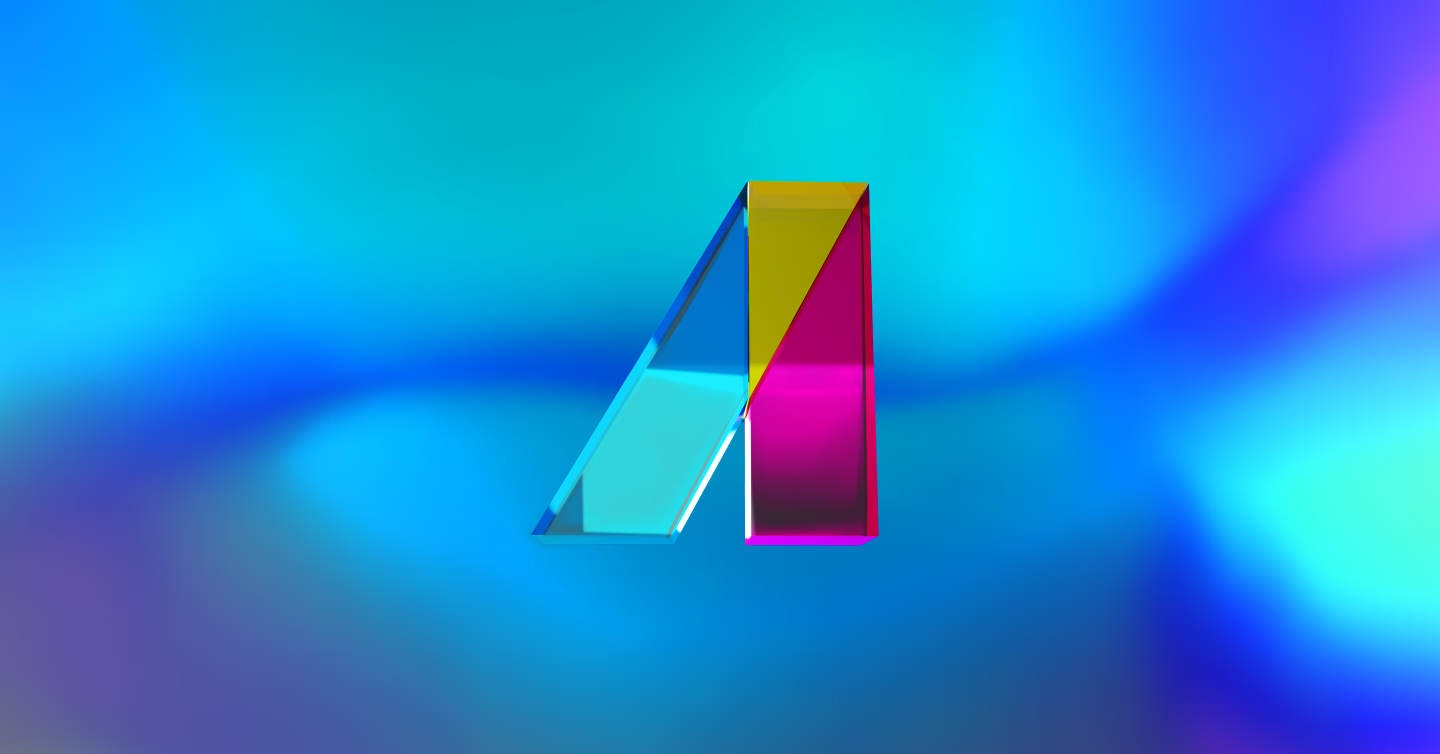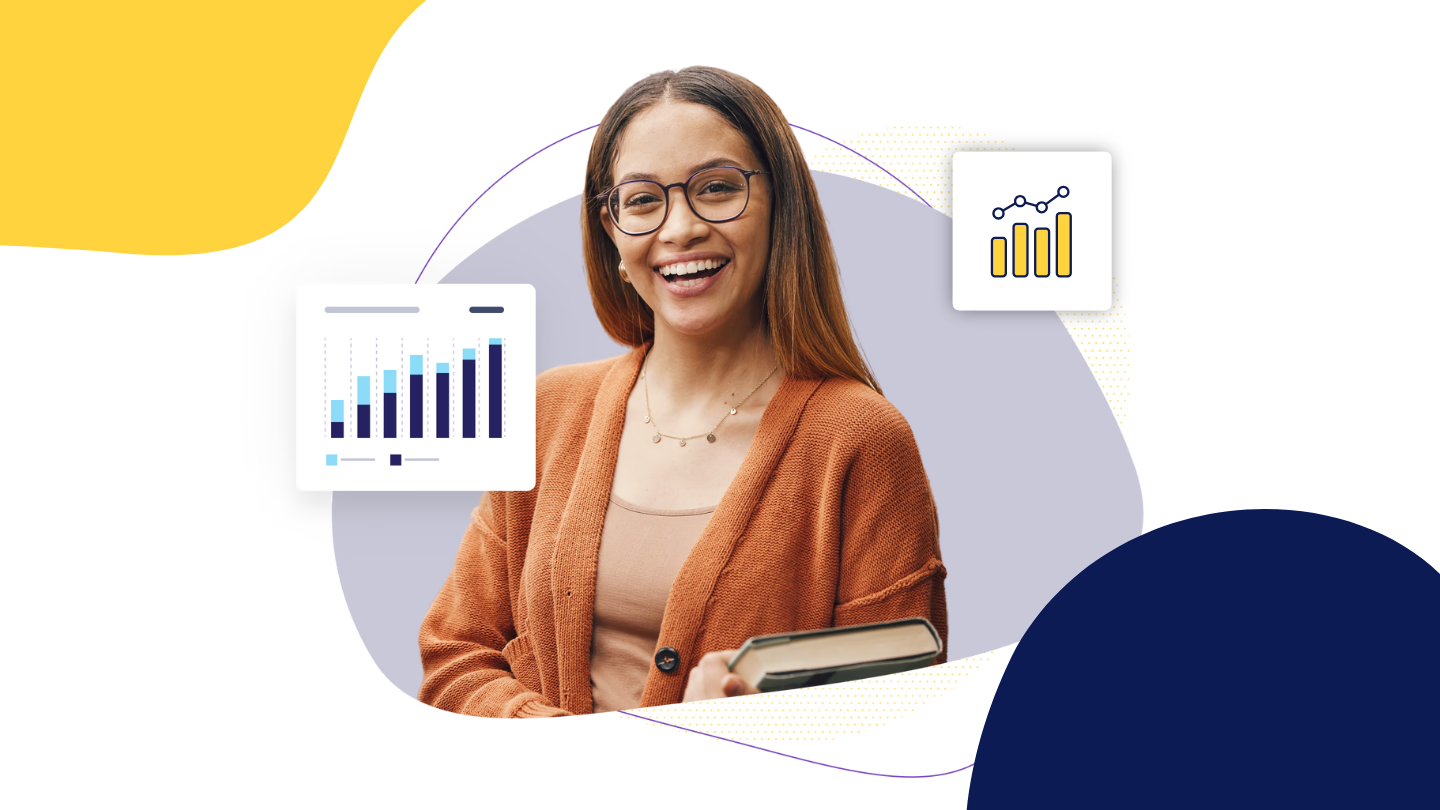If mentoring wasn’t on your 2025 bingo card, it should be. Social learning is one of the most underutilized approaches to workplace development, and the numbers show it. Absorb’s 2025 State of upskilling report found that more than 40% of organizations (43.6% to be exact) don’t offer any form of people-based learning, from mentoring to peer programs.
That gap matters because when employees miss out on human connection and collaboration, both learners and businesses lose. For learners, the impact is clear. Skills feel abstract without the context and feedback that come from a mentor, coach, or peer. Engagement dips, and knowledge doesn’t stick. For businesses, it translates into weaker retention and missed opportunities to prepare for the skills the future demands.
With Together mentoring software embedded in Absorb’s strategic learning system (SLS), organizations can unify social learning with their broader L&D strategy. Whether through structured coaching, peer connections, or casual coffee chats, it creates room for questions and sharing of experience that no piece of content can replicate. It turns learning into something that strengthens culture while driving measurable outcomes.
While online content and assessments are crucial for adult learning and development, mentorship is a learning modality that needs to be part of the equation if you want to see measurable results. Whether through structured coaching, peer connections, or casual coffee chats, it creates room for questions and shared experience that no piece of content can replicate. It turns learning into something that strengthens culture while driving measurable outcomes.
The result: deeper engagement, stronger retention, and performance gains that tie directly to business impact. In this blog, we’ll get into the tangible aspects of mentorship software: how it works, tools that keep programs running smoothly, and a customer story of its success.
A flexible mentorship matching approach
The first step: finding the right mentor. It isn’t luck, it’s informed matchmaking. And if Netflix can recommend your next favorite show, your mentoring platform should be able to recommend the right match too. Learning isn’t one-size-fits-all, and neither is mentoring.
Mentoring software within an LMS gives organizations the flexibility to design programs that fit different learning needs. This means no guesswork, biases, or manual matching. Each match, like the examples outlined below, is powered by an algorithm that pairs participants based on skills, goals, and availability, creating meaningful connections from the start.
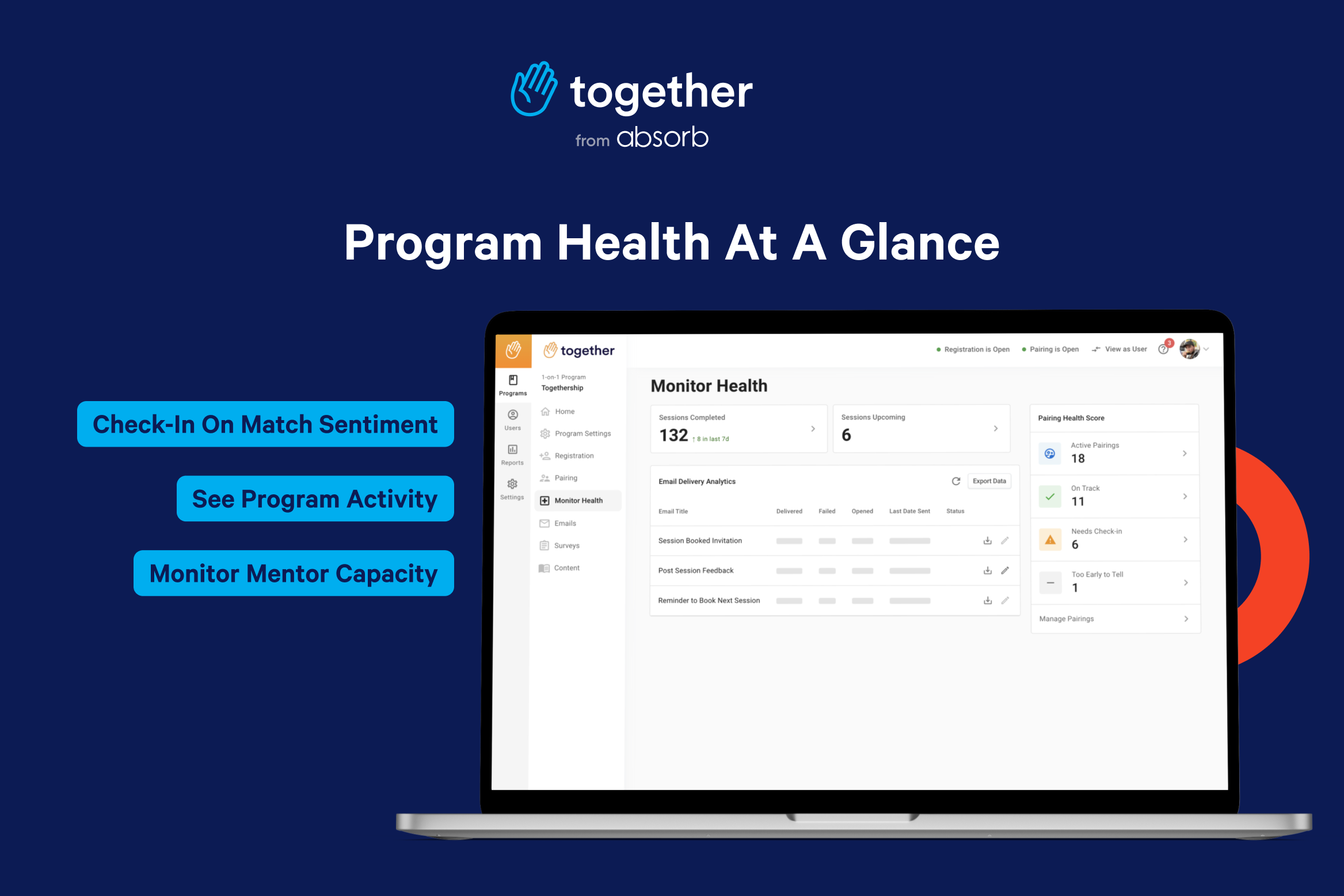
Mentoring platform for leadership development
Developing leaders is a long game, and content alone won’t get you there. What speeds up growth is pairing emerging managers with people who have already been in the seat. Together makes that easy with structured, long-term matches that connect high-potential talent to experienced leaders. These conversations cover the messy realities (IYKYK) of leadership. For instance, how to motivate a team, handle conflict, or make decisions with imperfect information.
Organizations get leaders who are more confident and better prepared. So instead of hoping new managers “figure it out,” mentoring and coaching build a pipeline that’s ready to step up when it matters.
Mentoring platform for peer upskilling and colleague connections
Upskilling isn’t always about a new course, though we’ll never turn down a good one. Often, it’s a more informal conversation with someone who’s already solved the problem you’re facing. Colleague Connect gives employees that opportunity by pairing peers for practical learning. Employees share experiences, offer support, and swap tips that make projects run smoothly.
The ripple effects reach the entire organization. Productivity increases and skills spread across departments with the support of a collaborative learning platform. When knowledge circulates this way, employees feel more connected to the people around them and the work they’re doing.
Mentoring platform for onboarding coffee chats
Starting a new job usually comes with a mix of excitement (hopefully) and nerves. The formal onboarding process covers the essentials, but new hires often want something less scripted, AKA the inside scoop on how things really work. Who’s the best person to ask for help? How do projects actually move forward? What’s the culture like once the slides are closed? Coffee chats create space for those conversations.
When new employees connect with peers in a relaxed setting, they find their footing faster and feel more confident stepping into their roles. Pairings are also randomized, introducing them to colleagues they might not meet otherwise. That early support pays off. Employees who feel welcomed from the start are more engaged and begin contributing sooner.
Onboarding is just one of many use cases for the Coffee Chats feature, it facilitates any and all organic, spontaneous employee networking - basically replicating the water cooler in a virtual environment.
Integrated into your workflow from day one
Mentorship and coaching matches only work if your people use your platform. To make that happen, it needs to sync with the tools they already know. Absorb and Together do exactly that, so your mentorship software fits with existing learning HRIS and SSO workflows, simplifying registration and pre-populating data. It also integrates with everyday platforms like Slack, Microsoft Teams, calendars, and email, so scheduling happens without switching apps. Employees can stay focused on the conversation instead of managing extra logins.
For L&D and HR teams, integration lightens the workload in noticeable ways. Reporting is easier to manage because the data flows into one system. Segmenting programs by role or department takes a fraction of the time. And program owners aren’t stuck piecing together spreadsheets or chasing down updates. Instead, they can see progress in their preferred system and keep the focus on building programs that make an impact.
The learner experience also improves when the tech disappears into the background. Employees can join mentoring sessions from their calendars, get reminders in chat tools they already use, and carry on without disruption. That simplicity keeps participation high and prevents mentoring from feeling like an extra task on an already long list.
Connecting mentoring to OKRs and business priorities
Along with many other L&D initiatives, one of the toughest parts of running a mentoring program is proving its value. While the benefits like better connections and stronger engagement feel obvious, leaders still need evidence. Fortunately, Absorb and Together deliver that clarity with dashboards designed for outcome reporting and ROI measurement.
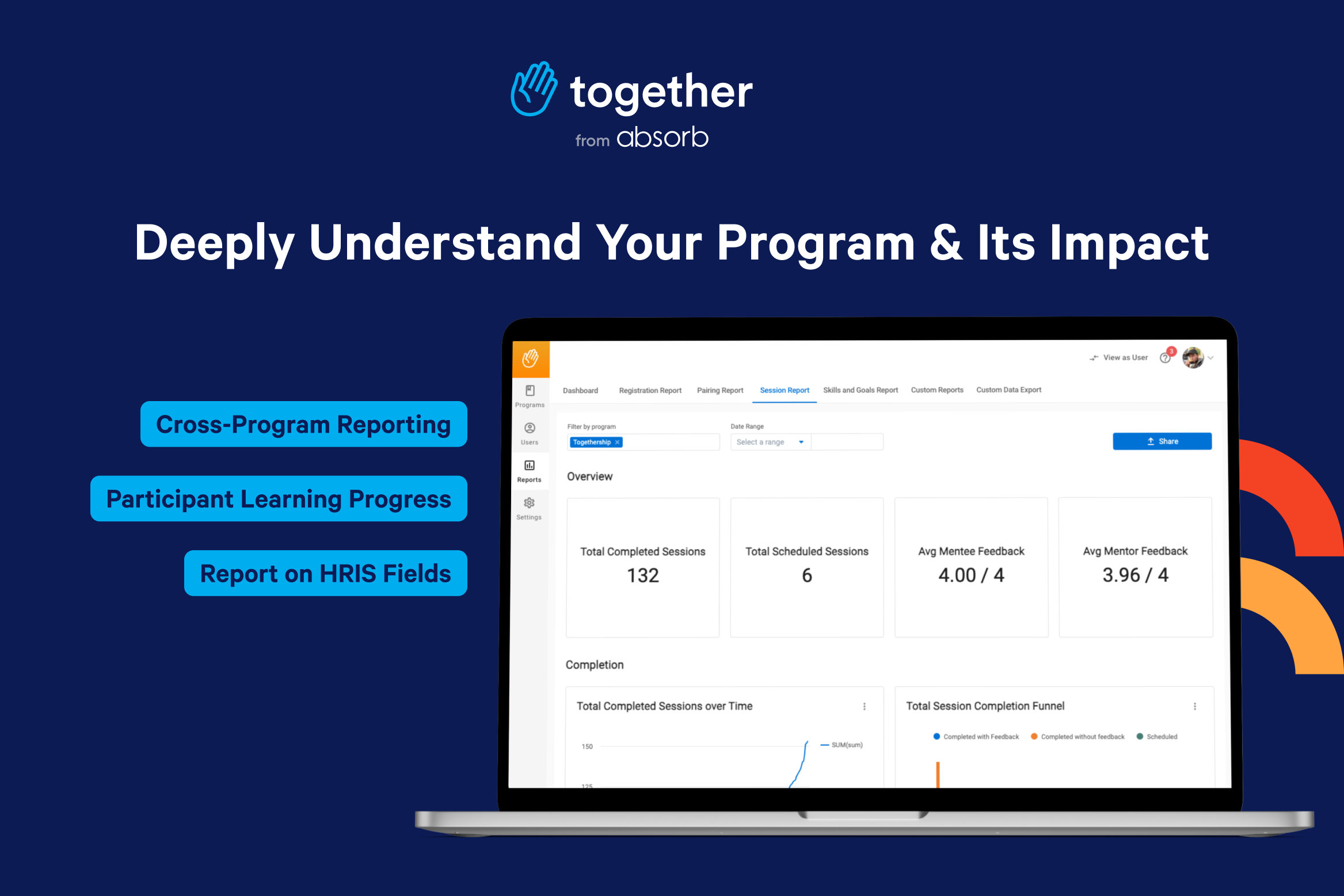
With a full reporting suite, L&D and HR teams get visibility into activity whenever they need it. Program owners can see how many employees are signing up, how often sessions are happening, and whether participants are reaching the goals they set. That level of detail helps teams understand how the program is unfolding as it happens, rather than months later in a year-end review.
Feedback tools add another layer of perspective. Surveys show how mentors and mentees feel about their pairing and if the experience is helping them grow. When that input is paired with participation data, teams get a clearer view of leadership readiness and productivity gains. Outcomes like these are notoriously tough to pin down in traditional mentoring programs.
Dashboards also connect mentoring and coaching progress to company OKRs. Leaders can see how participation lines up with broader objectives, whether that means reducing turnover or developing managers. That connection makes it easier to show ROI in both people outcomes and cost savings. For example, ROI could look like lower recruiting spend or hiring costs due to higher retention.
This visibility makes it easier to keep programs healthy over time. If participation begins to dip, leaders can step in quickly. If a certain group of employees is thriving, those insights can guide future matches. Instead of running on assumptions, program owners have data they can act on.
The impact isn’t limited to program management. Clear analytics give leaders evidence that mentoring improves employee experience and strengthens the organization. It shows how mentoring supports daily work while also contributing to long-term goals. And when results are this clear, leaders feel more confident investing in the program.
AI support meets human connection
Every great mentoring program has two sides: the people driving the conversations and the behind-the-scenes work that makes those conversations possible. The people part is energizing. The admin part? A little less so. That’s where AI comes in. More specifically, AI supports the mentoring platform with personalized agendas and prompts.
Together uses AI-generated agendas to keep participation steady. The system reads participant profiles and prior discussion notes to suggest what to cover in the next session. Every meeting feels like it was made with intention, not pulled from a Google search.
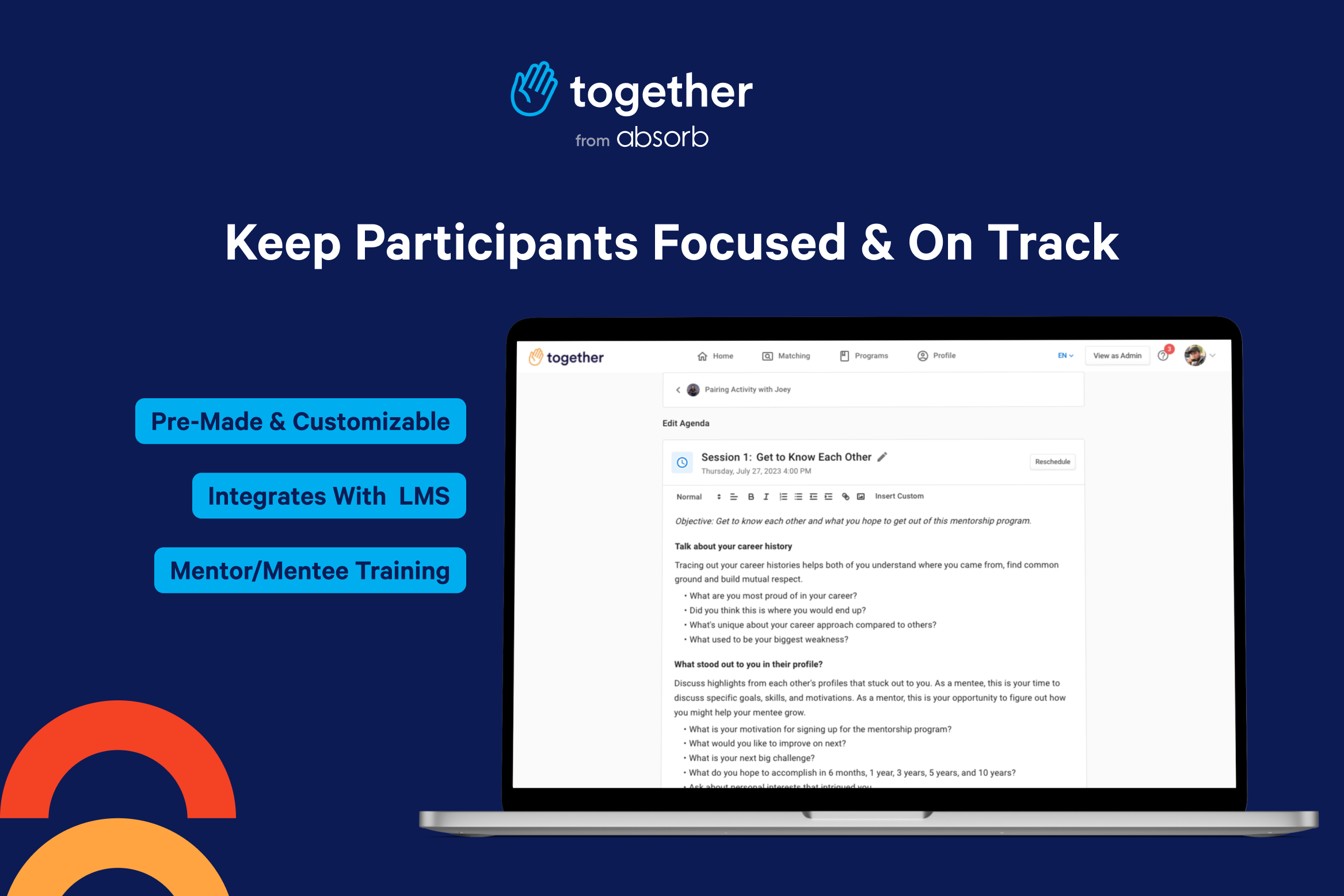
Learners can even nudge AI toward areas they care about most. Think of it as a “choose your own adventure” for professional growth. If a mentee wants to sharpen presentation skills, for example, the platform can surface discussion points to guide that prep.
For program owners, AI does most of the legwork behind the scenes. It can help you brainstorm and build programs in minutes, not months. And for leaders, this means mentorship and coaching programs aren’t only easier to launch; they’re easier to tie to strategy. AI helps programs align with company goals, like better preparing managers. That connection shifts mentoring from a side initiative to a growth driver.
And while the technology runs in the background, the conversations stay deeply human. AI handles the setup and follow-through so people can focus on the piece that’s uniquely human: connection.
Wellabe: An enterprise mentoring platform case study
So, what does all of this look like in practice? Let’s take a closer look at Wellabe.
Wellabe, a 400-person insurance company, always believed in the value of mentoring. The program they had in place was meaningful, but it was also manual. HR spent days collecting intake forms, matching participants, and coordinating schedules. Each cycle consumed 20 to 30 hours of work and capped participation at 26 employees, less than 10 percent of the workforce. The experience was strong for those involved, yet the scale and impact fell short of what the company envisioned.
That shifted when senior learning and development specialist, Joey Spivey, introduced Together. User-led matching and AI-generated agendas reduced the hands-on support needed. Integrations eliminated roadblocks that tend to disincentivize users. Plus, the team expanded from a single program into four: traditional career mentoring, coffee chats, leadership development for high-potential employees, and onboarding support for new hires.
The change was immediate. Participation quadrupled, engagement survey scores jumped by more than 20 points, and turnover stayed well below industry averages during a period of CEO transition and product restructuring. Mentoring became a core part of the employee experience, shaping culture and retention across the company.
As Joey explained, “We knew mentoring worked. We just needed a way to let more people in and do it even better.” With Together, Wellabe found the scale and personalization they needed, creating a mentoring ecosystem that reaches across the entire organization. Wellabe’s story is one of many we’ve seen that shows what happens when mentoring moves from a small, manual process to a scalable, strategic program.
Interested in the full scoop on Wellabe? Read the full case study
Meet the Mentorship Guild community for L&D leaders
Mentoring is a powerful, underleveraged tool for activating social learning. And with an SLS, the challenges that often hold programs back, like scaling matches and connecting to business goals, start to fade. Still, mentoring is more than software. It’s built on honest conversations and shared experience. That’s the idea behind the Mentorship Guild.
Think of it as your go-to spot for all things mentoring. It’s a free community built for L&D and HR leaders who want more than theory. Here, you’ll hear what’s working inside real organizations, get matched with peers, and access practical resources to develop your skills.
The Guild isn’t another library of static content. It’s alive with discussions and shared experiences. Some members join for mentors or peer connections. Others come for virtual events and industry reports. But everyone leaves with practical ideas they can apply and connections that last.
If you’ve ever wanted a place to ask “what would you do?” and get answers from people who’ve been there, this is it. If you couldn’t already tell, we’re really excited about this community, and we hope you are too. Check out the Mentorship Guild to get a feel for it yourself.




